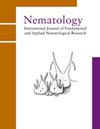Schistonchus pumilae n. sp. isolated from syconia of a creeper fig, Ficus pumila L. from the Japanese warm temperate zone
IF 1.2
4区 生物学
Q2 ZOOLOGY
引用次数: 1
Abstract
A Schistonchus species was isolated from the syconia of the creeping fig, Ficus pumila, collected from Miyazaki, Japan. The nematode was considered an undescribed species based on its typological characters, molecular profiles (near full length of small subunit and D3 expansion segment of large subunit of RNA) and phylogenetic status inferred from these two loci. The new species is characterised by the presence of flagellate sperm, spicule possessing small condylus, triangular rostrum with bluntly pointed tip and clear dorsal and ventral limbs, structure and arrangement of male caudal papillae, i.e., presence of papilliform P3 and P3a and small and gland opening-like P4 (glandpapillae), relatively short post-uterine sac and female tail forming elongate conoid. It is phylogenetically close to S. hirtus. However, the new species is distinguished from other nominal Schistonchus species by its female tail shape forming elongate conoid, the structure and arrangement of male caudal papillae and several other typological characters. In addition, the host fig of the nematode, F. pumila, is a creeper fig species belonging to subgenus Synoecia (section Rhizocladus; subsection Plagiostigma), from which no fig-associated nematode has been reported so far, i.e., the present study is the first report of Schistonchus (and other syconia-inhabiting nematodes) from the Ficus subgenus Synoecia.从日本暖温带的攀缘无花果(Ficus pumila L.)的悬铃木中分离得到的短柄木(Schistonchus pumilae n.sp.)
从日本宫崎采集的攀缘无花果(Ficus pumila)的悬铃木中分离出一个Schistochus物种。根据这两个基因座推断的线虫的类型学特征、分子图谱(RNA的小亚基接近全长和大亚基的D3扩增段)和系统发育状况,该线虫被认为是一个未描述的物种。新物种的特征是存在鞭毛精子、具有小髁突的针状物、具有钝尖尖端和清晰的背侧和腹侧肢体的三角形主席台、雄性尾乳头的结构和排列,即存在乳头状P3和P3a以及小而腺开口状P4(腺顶),相对较短的子宫后囊和雌尾形成细长的圆锥形。它在系统发育上接近汗毛猴。然而,该新物种与其他名义上的斯氏锥虫物种的区别在于其雌性尾巴形状形成细长的圆锥形,雄性尾乳头的结构和排列以及其他一些类型学特征。此外,该线虫的寄主无花果F.pumila是一种爬行无花果物种,属于Synoecia亚属(根枝亚属;Plagiostigma亚属),迄今为止尚未报道与无花果相关的线虫,即本研究是首次报道Ficus Synoecia亚属的Schistochus(和其他居住在悬铃木上的线虫)。
本文章由计算机程序翻译,如有差异,请以英文原文为准。
求助全文
约1分钟内获得全文
求助全文
来源期刊

Nematology
生物-动物学
CiteScore
2.60
自引率
33.30%
发文量
67
审稿时长
3 months
期刊介绍:
Nematology is an international journal for the publication of all aspects of nematological research (with the exception of vertebrate parasitology), from molecular biology to field studies. Papers on nematode parasites of arthropods, and on soil free-living nematodes, and on interactions of these and other organisms, are particularly welcome. Research on fresh water and marine nematodes is also considered when the observations are of more general interest.
Nematology publishes full research papers, short communications, Forum articles (which permit an author to express a view on current or fundamental subjects), perspectives on nematology, and reviews of books and other media.
 求助内容:
求助内容: 应助结果提醒方式:
应助结果提醒方式:


